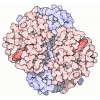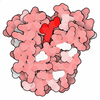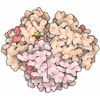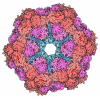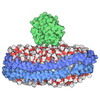+ Open data
Open data
- Basic information
Basic information
| Entry | Database: PDB / ID: 8r83 | ||||||||||||||||||
|---|---|---|---|---|---|---|---|---|---|---|---|---|---|---|---|---|---|---|---|
| Title | pentameric IgMFc-AIM complex global refinement | ||||||||||||||||||
 Components Components |
| ||||||||||||||||||
 Keywords Keywords | IMMUNE SYSTEM / Scavenger Receptor Cysteine-Rich / IgM | ||||||||||||||||||
| Function / homology |  Function and homology information Function and homology informationpositive regulation of complement-dependent cytotoxicity / dimeric IgA immunoglobulin complex / secretory dimeric IgA immunoglobulin complex / pentameric IgM immunoglobulin complex / monomeric IgA immunoglobulin complex / secretory IgA immunoglobulin complex / IgA binding / regulation of complement activation / glomerular filtration / immunoglobulin receptor binding ...positive regulation of complement-dependent cytotoxicity / dimeric IgA immunoglobulin complex / secretory dimeric IgA immunoglobulin complex / pentameric IgM immunoglobulin complex / monomeric IgA immunoglobulin complex / secretory IgA immunoglobulin complex / IgA binding / regulation of complement activation / glomerular filtration / immunoglobulin receptor binding / positive regulation of respiratory burst / humoral immune response / immune system process / cellular defense response / Scavenging of heme from plasma / antigen binding / Cell surface interactions at the vascular wall / antibacterial humoral response / protein-containing complex assembly / protein-macromolecule adaptor activity / blood microparticle / adaptive immune response / immune response / inflammatory response / innate immune response / apoptotic process / cell surface / protein homodimerization activity / extracellular space / extracellular exosome / extracellular region / plasma membrane / cytoplasm Similarity search - Function | ||||||||||||||||||
| Biological species |  Homo sapiens (human) Homo sapiens (human) | ||||||||||||||||||
| Method | ELECTRON MICROSCOPY / single particle reconstruction / cryo EM / Resolution: 3.57 Å | ||||||||||||||||||
 Authors Authors | Chen, Q. / Arai, S. / Miyazaki, T. / Rosenthal, P. | ||||||||||||||||||
| Funding support |  United Kingdom, United Kingdom,  Japan, 5items Japan, 5items
| ||||||||||||||||||
 Citation Citation |  Journal: Nat Commun / Year: 2024 Journal: Nat Commun / Year: 2024Title: Cryo-EM reveals structural basis for human AIM/CD5L recognition of polymeric immunoglobulin M. Authors: Qu Chen / Kazuhiro Ishii / Haruka Mori / Akemi Nishijima / Satoko Arai / Toru Miyazaki / Peter B Rosenthal /    Abstract: Cell surface scavenger receptors contribute to homoeostasis and the response to pathogens and products associated with damage by binding to common molecular features on a wide range of targets. ...Cell surface scavenger receptors contribute to homoeostasis and the response to pathogens and products associated with damage by binding to common molecular features on a wide range of targets. Apoptosis inhibitor of macrophage (AIM/CD5L) is a soluble protein belonging to the scavenger receptor cysteine-rich (SRCR) superfamily that contributes to prevention of a wide range of diseases associated with infection, inflammation, and cancer. AIM forms complexes with IgM pentamers which helps maintain high-levels of circulating AIM in serum for subsequent activation on release from the complex. The structural basis for AIM recognition of IgM as well as other binding targets is unknown. Here we apply cryogenic electron microscopy imaging (cryo-EM) to show how interfaces on both of AIM's C-terminal SRCR domains interact with the Fcμ constant region and J chain components of the IgM core. Both SRCR interfaces are also shown to contribute interactions important for AIM binding to damage-associated molecular patterns (DAMPs). | ||||||||||||||||||
| History |
|
- Structure visualization
Structure visualization
| Structure viewer | Molecule:  Molmil Molmil Jmol/JSmol Jmol/JSmol |
|---|
- Downloads & links
Downloads & links
- Download
Download
| PDBx/mmCIF format |  8r83.cif.gz 8r83.cif.gz | 524.5 KB | Display |  PDBx/mmCIF format PDBx/mmCIF format |
|---|---|---|---|---|
| PDB format |  pdb8r83.ent.gz pdb8r83.ent.gz | 420.8 KB | Display |  PDB format PDB format |
| PDBx/mmJSON format |  8r83.json.gz 8r83.json.gz | Tree view |  PDBx/mmJSON format PDBx/mmJSON format | |
| Others |  Other downloads Other downloads |
-Validation report
| Summary document |  8r83_validation.pdf.gz 8r83_validation.pdf.gz | 1.4 MB | Display |  wwPDB validaton report wwPDB validaton report |
|---|---|---|---|---|
| Full document |  8r83_full_validation.pdf.gz 8r83_full_validation.pdf.gz | 1.5 MB | Display | |
| Data in XML |  8r83_validation.xml.gz 8r83_validation.xml.gz | 90.2 KB | Display | |
| Data in CIF |  8r83_validation.cif.gz 8r83_validation.cif.gz | 133.1 KB | Display | |
| Arichive directory |  https://data.pdbj.org/pub/pdb/validation_reports/r8/8r83 https://data.pdbj.org/pub/pdb/validation_reports/r8/8r83 ftp://data.pdbj.org/pub/pdb/validation_reports/r8/8r83 ftp://data.pdbj.org/pub/pdb/validation_reports/r8/8r83 | HTTPS FTP |
-Related structure data
| Related structure data |  18993MC  8r84C M: map data used to model this data C: citing same article ( |
|---|---|
| Similar structure data | Similarity search - Function & homology  F&H Search F&H Search |
- Links
Links
- Assembly
Assembly
| Deposited unit | 
|
|---|---|
| 1 |
|
- Components
Components
-Protein , 3 types, 12 molecules NBCDLKHGEFAJ
| #1: Protein | Mass: 36100.250 Da / Num. of mol.: 1 Source method: isolated from a genetically manipulated source Source: (gene. exp.)  Homo sapiens (human) / Gene: CD5L / Production host: Homo sapiens (human) / Gene: CD5L / Production host:  | ||
|---|---|---|---|
| #2: Protein | Mass: 39715.379 Da / Num. of mol.: 10 Source method: isolated from a genetically manipulated source Source: (gene. exp.)  Homo sapiens (human) / Production host: Homo sapiens (human) / Production host:  #3: Protein | | Mass: 19306.881 Da / Num. of mol.: 1 Source method: isolated from a genetically manipulated source Source: (gene. exp.)  Homo sapiens (human) / Gene: JCHAIN / Production host: Homo sapiens (human) / Gene: JCHAIN / Production host:  |
-Sugars , 2 types, 7 molecules 
| #4: Polysaccharide | 2-acetamido-2-deoxy-beta-D-glucopyranose-(1-4)-2-acetamido-2-deoxy-beta-D-glucopyranose Source method: isolated from a genetically manipulated source |
|---|---|
| #6: Sugar | ChemComp-NAG / |
-Non-polymers , 1 types, 2 molecules 
| #5: Chemical |
|---|
-Details
| Has ligand of interest | Y |
|---|---|
| Has protein modification | Y |
-Experimental details
-Experiment
| Experiment | Method: ELECTRON MICROSCOPY |
|---|---|
| EM experiment | Aggregation state: PARTICLE / 3D reconstruction method: single particle reconstruction |
- Sample preparation
Sample preparation
| Component | Name: human IgM-Fc/AIM complex / Type: COMPLEX / Entity ID: #1-#3 / Source: MULTIPLE SOURCES |
|---|---|
| Source (natural) | Organism:  Homo sapiens (human) Homo sapiens (human) |
| Source (recombinant) | Organism:  Homo sapiens (human) Homo sapiens (human) |
| Buffer solution | pH: 7.5 |
| Specimen | Conc.: 1.3 mg/ml / Embedding applied: NO / Shadowing applied: NO / Staining applied: NO / Vitrification applied: YES |
| Vitrification | Cryogen name: ETHANE |
- Electron microscopy imaging
Electron microscopy imaging
| Experimental equipment |  Model: Titan Krios / Image courtesy: FEI Company |
|---|---|
| Microscopy | Model: FEI TITAN KRIOS |
| Electron gun | Electron source:  FIELD EMISSION GUN / Accelerating voltage: 300 kV / Illumination mode: FLOOD BEAM FIELD EMISSION GUN / Accelerating voltage: 300 kV / Illumination mode: FLOOD BEAM |
| Electron lens | Mode: BRIGHT FIELD / Nominal defocus max: 3500 nm / Nominal defocus min: 1200 nm |
| Image recording | Electron dose: 52.4 e/Å2 / Film or detector model: GATAN K2 QUANTUM (4k x 4k) |
- Processing
Processing
| CTF correction | Type: PHASE FLIPPING AND AMPLITUDE CORRECTION |
|---|---|
| 3D reconstruction | Resolution: 3.57 Å / Resolution method: FSC 0.143 CUT-OFF / Num. of particles: 501789 / Symmetry type: POINT |
 Movie
Movie Controller
Controller




 PDBj
PDBj